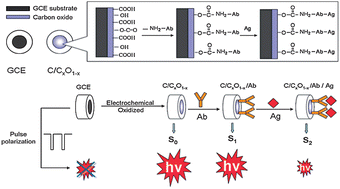Cathodic electrochemiluminescence at C/CxO1−xelectrodes for the fabrication of label-free biosensors†
Abstract
Cathodic electrochemiluminescence (

* Corresponding authors
a
Key Laboratory of Analysis and Detection for Food Safety (Ministry of Education), and Fujian Provincial Key Laboratory of Analysis and Detection for Food Safety, Department of Chemistry, Fuzhou University, Fuzhou 350108, China
E-mail:
JJSun@fzu.edu.cn
Fax: +86-591-22866136
Tel: +86-591-22866136
b Department of Pharmaceutical Analysis, Faculty of Pharmacy, Fujian Medical University, Fuzhou 350004, China
Cathodic electrochemiluminescence (

 Please wait while we load your content...
Something went wrong. Try again?
Please wait while we load your content...
Something went wrong. Try again?
A. Wu, J. Sun, X. Su, Y. Lin, Z. Lin, H. Yang and G. Chen, Analyst, 2010, 135, 2309 DOI: 10.1039/B924403D
To request permission to reproduce material from this article, please go to the Copyright Clearance Center request page.
If you are an author contributing to an RSC publication, you do not need to request permission provided correct acknowledgement is given.
If you are the author of this article, you do not need to request permission to reproduce figures and diagrams provided correct acknowledgement is given. If you want to reproduce the whole article in a third-party publication (excluding your thesis/dissertation for which permission is not required) please go to the Copyright Clearance Center request page.
Read more about how to correctly acknowledge RSC content.
 Fetching data from CrossRef.
Fetching data from CrossRef.
This may take some time to load.
Loading related content
